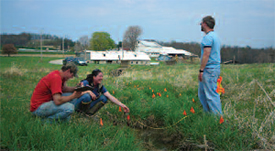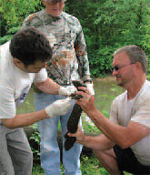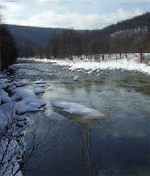Protecting & Restoring Rivers and Streams
In 2010, the Conservancy protected or improved 268 stream miles throughout Western Pennsylvania and partnered with 111 watershed and other conservation groups to achieve a shared vision: clean, healthy waterways that sustain wildlife, provide clean drinking water, create recreational opportunities and support local economies for the long-term.

Streambank and water quality testing, Little Mahoning Creek watershed
The Conservancy collaborated with local groups to complete watershed assessments and management plans for the Sewickley Creek watershed in Westmoreland County; Buffalo Creek and Chartiers Creek watersheds in Washington County; and Little Mahoning Creek watershed in Indiana County. Partnering with grassroots organizations ensures that local communities continue to invest in the current and future health of their rivers and streams - long after WPC-led projects are completed.
WPC also partnered with farmers, landowners, businesses and other groups to implement 298 improvement projects that identified and addressed numerous sources of water pollution. WPC staff assisted 62 agricultural operations, rehabilitated or replaced seven on-lot septic systems, and installed three abandoned mine treatment (AMD) systems.
The Conservancy also planted 380 acres of warm season grasses that provide wildlife habitat and help to prevent pollution caused by runoff into rivers and streams.

Eastern hellbender research, Tubmill Creek
In one of the year's more significant projects, WPC and partners removed the 72-year-old Savan Dam on Little Mahoning Creek. More than 100 feet long and five feet wide, this concrete structure served no purpose, and its removal reconnected 21 miles of headwaters back to the lower section of the watershed.
In addition to Little Mahoning Creek, rivers and streams protected through Conservancy projects in 2010 included Halfmoon Creek in Huntingdon County, Deer Creek in Lawrence County, Tubmill Creek in Westmoreland County and many others.
The local rivers and streams improved by WPC's work affect the water quality of larger rivers and water bodies, such as the Chesapeake Bay and the Allegheny and Ohio rivers, making the collective impact of the Conservancy's work significant nationally and globally.

Casselman River
Recognizing that people's care for the environment often begins with positive experiences in nature, the Conservancy also worked to improve recreational access to waterways through the Canoe Access Development Fund. Made possible through the generosity of WPC members Roy Weil and Mary Shaw, this annual fund supported new canoe and kayak access projects on the Conemaugh River and Little Mahoning Creek in 2010.
Also in 2010, the Conservancy held a Local Water Summit to support Pittsburgh's role as the host city for World Environment Day. The event for members and the media charted the Conservancy's progress in improving local waterways, discussed current opportunities and challenges, and described the critical role of everyday citizens in protecting the region's rivers and streams.
